Geomorphology of a Holocene Hurricane Deposit Eroded from Rhyolite Sea Cliffs on Ensenada Almeja (Baja California Sur, Mexico)
Abstract
:1. Introduction
2. Geographical and Geological Setting
3. Materials and Methods
3.1. Data Collection
3.2. Hydraulic Model
4. Results
4.1. Sample Density Calculation
4.2. Aerial Photography
4.3. Source Rock and Natural Weathering
4.4. Mapping and Installation of Sampling Transcects
4.5. Analysis of Boulder Shapes
4.6. Analysis of Boulder Sizes
4.7. Estimation of Wave Heights
5. Discussion
5.1. Tidal Influence on Coastal Sediment Production
5.2. Seasonal Wind Patterns and Long-Shore Currents
5.3. Extra-regional Tsunami Activity
5.4. Hurricane Frequency
5.5. Human Occupation of the San Basilio Area
5.6. Regional Patterns for Coastal Boulder Beds
5.7. Comparison to Selected CBBs Elsewhere in the World
6. Conclusions
- Hurricanes strike Mexico’s Baja California peninsula and enter the Gulf of California with increased frequency especially during El Niño years commonly repeated every 6 to 8 years. The last hurricane known to reach Ensenada Almeja in the San Basilio area north of Loreto was Hurricane Odile in 2014.
- By process of elimination taking into account more frequent but less energetic sources of input such as tidal forces, seasonal wind patterns involved with long-shore currents, as well as tsunamis, data are found to favor an incremental accumulation of the Ensenada Almeja CBB due to a repetition of hurricane events through Holocene time.
- Maximum wave height stimulated by a major storm necessary to erode the largest blocks of banded rhyolite with a calculated specific gravity of 2.16 is estimated to have been on the order of 13.7 m.
- Evidence based on size distribution in boulders from four different transects crossing perpendicular through the Almeja CBB shows a decrease in maximum size along a curved shoreline ending 230 m distal from the bedrock source on the outer tip of the adjacent headland. Loss of energy is due to wave refraction entering Ensenada Almeja after impact against the headland with wave surge arriving from the east driven by a counter-clockwise rotation of a hurricane system.
- The restriction of embayments by CBBs and the related closure of lagoons by boulder spurs in the form of unconsolidated bars, derived from bedrock sources of basalt and andesite, is a widespread pattern in the Gulf of California. Future efforts that distinguish between different energy sources related to coastal erosion of exposed bedrock must take into consideration the importance of hurricanes and down-graded tropical storms that impact the region on an episodic basis. Like rhyolite (this study), basalt and andesite are susceptible to intense hydrologic pressure exerted against parting seams and vertical joints exposed to wave action during major storms.
Supplementary Materials
Author Contributions
Funding
Acknowledgments
Conflicts of Interest
Appendix A
| Sample | Distance to Next (cm) | Long Axis (cm) | Intermediate Axis (cm) | Short Axis (cm) | Volume (cm3) | Adjust. to 65% | Weight (kg) | Estimated Wave ht. (m) |
|---|---|---|---|---|---|---|---|---|
| 1 | 0 | 88 | 44 | 38 | 147,136 | 95,638 | 207 | 5.5 |
| 2 | +20 | 58 | 40 | 36 | 83,520 | 54,288 | 219 | 3.6 |
| 3 | +60 | 108 | 60 | 44 | 285,120 | 185,328 | 296 | 6.8 |
| 4 | +90 | 70 | 64 | 47 | 210,560 | 136,864 | 647 | 4.4 |
| 5 | +104 | 110 | 81 | 523 | 463,320 | 301,158 | 651 | 6.9 |
| 6 | +320 | 116 | 74 | 50 | 429,200 | 278,980 | 603 | 7.3 |
| 7 | +108 | 112 | 82 | 45 | 413,280 | 268,632 | 580 | 7.0 |
| 8 | +100 | 92 | 52 | 43 | 205,712 | 133,713 | 289 | 5.8 |
| 9 | +100 | 155 | 115 | 93 | 1,657,725 | 1,077,521 | 2327 | 9.7 |
| 10 | +140 | 92 | 88 | 60 | 485,760 | 315,744 | 682 | 5.8 |
| 11 | +208 | 208 | 118 | 78 | 2,470,624 | 1,605,906 | 3469 | 13.0 |
| 12 | +330 | 120 | 56 | 50 | 336,000 | 218,400 | 472 | 7.5 |
| 13 | +220 | 268 | 111 | 104 | 3,093,792 | 2,010,965 | 4344 | 16.8 |
| 14 | +150 | 97 | 74 | 30 | 215,340 | 139,971 | 302 | 6.1 |
| 15 | +100 | 153 | 126 | 98 | 1,889,244 | 1,228,009 | 2653 | 9.6 |
| 16 | +150 | 108 | 84 | 44 | 399,168 | 259,459 | 560 | 6.8 |
| 17 | +80 | 105 | 60 | 33 | 207,900 | 135,135 | 292 | 6.6 |
| 18 | +0 | 92 | 80 | 34 | 250,240 | 162,656 | 351 | 5.8 |
| 19 | +120 | 125 | 118 | 75 | 1,106,250 | 719,063 | 1553 | 7.8 |
| 20 | +0 | 87 | 66 | 38 | 218,196 | 141,827 | 306 | 5.5 |
| 21 | +100 | 130 | 121 | 60 | 943,800 | 613,470 | 1325 | 8.2 |
| 22 | +200 | 214 | 94 | 85 | 1,709,860 | 1,111,409 | 2401 | 13.4 |
| 23 | +0 | 78 | 62 | 334 | 164,424 | 106,876 | 231 | 4.9 |
| 24 | +100 | 128 | 53 | 38 | 257,792 | 167,565 | 362 | 8.0 |
| 25 | +100 | 218 | 148 | 108 | 3,484,512 | 2,264,933 | 4892 | 13.7 |
| Average | +158 | 125 | 83 | 57 | 845,139 | 549,340 | 1201 | 7.9 |
| Sample | Distance to Next (cm) | Long Axis (cm) | Intermediate Axis (cm) | Short Axis (cm) | Volume (cm3) | Adjust. to 65% | Weight (kg) | Estimated Wave ht. (m) |
|---|---|---|---|---|---|---|---|---|
| 1 | 0 | 83 | 63 | 24 | 125,496 | 81,572 | 176 | 5.2 |
| 2 | +130 | 62 | 31 | 60 | 30,752 | 19,989 | 43 | 3.9 |
| 3 | +220 | 74 | 45 | 33 | 49,728 | 32,323 | 70 | 4.6 |
| 4 | +200 | 66 | 50 | 34 | 98,010 | 63,707 | 138 | 4.1 |
| 5 | +600 | 172 | 67 | 46 | 122,400 | 79,560 | 172 | 10.8 |
| 6 | +140 | 86 | 69 | 21 | 284,832 | 185,141 | 400 | 5.4 |
| 7 | +260 | 68 | 27 | 26 | 38,556 | 25,061 | 54 | 4.3 |
| 8 | +150 | 75 | 35 | 25 | 65,626 | 42,656 | 92 | 4.7 |
| 9 | +700 | 64 | 48 | 29 | 89,089 | 57,907 | 125 | 4.0 |
| 10 | +150 | 128 | 42 | 39 | 209,664 | 136,282 | 294 | 8.0 |
| 11 | +130 | 61 | 56 | 38 | 129,808 | 84,375 | 182 | 3.8 |
| 12 | +900 | 98 | 81 | 28 | 222,264 | 144,472 | 312 | 6.2 |
| 13 | +200 | 92 | 58 | 55 | 293,480 | 190,762 | 412 | 5.8 |
| 14 | +0 | 74 | 51 | 33 | 124,542 | 80,952 | 175 | 4.6 |
| 15 | +800 | 108 | 64 | 38 | 262,656 | 170,726 | 369 | 6.8 |
| 16 | +310 | 115 | 83 | 48 | 458,160 | 297,804 | 643 | 7.2 |
| 17 | +10 | 125 | 85 | 53 | 563,125 | 336,031 | 726 | 7.8 |
| 18 | +200 | 108 | 85 | 48 | 440,640 | 286,416 | 619 | 6.8 |
| 19 | +100 | 106 | 55 | 45 | 262,350 | 170,528 | 368 | 6.7 |
| 20 | +220 | 113 | 71 | 58 | 465,334 | 302,467 | 653 | 7.1 |
| 21 | 0 | 135 | 95 | 73 | 936,225 | 608,546 | 1314 | 8.5 |
| 22 | +330 | 83 | 78 | 48 | 310,752 | 201,993 | 436 | 5.2 |
| 23 | +250 | 88 | 73 | 88 | 234,048 | 217,131 | 469 | 5.5 |
| 24 | +40 | 94 | 91 | 19 | 752,752 | 489,293 | 1057 | 5.9 |
| 25 | +60 | 101 | 93 | 44 | 413,292 | 268,640 | 583 | 6.3 |
| Average | 100 | 91 | 63 | 41 | 283,343 | 182,974 | 395 | 6.0 |
| Sample | Distance to next (cm) | Long axis (cm) | Intermediate axis (cm) | Short axis (cm) | Volume (cm3) | Adjust. to 65% | Weight (kg) | Estimated Wave ht. (m) |
|---|---|---|---|---|---|---|---|---|
| 1 | 0 | 79 | 38 | 21 | 63,042 | 40,977 | 89 | 5.0 |
| 2 | +400 | 76 | 53 | 38 | 153,064 | 99,492 | 215 | 4.8 |
| 3 | +100 | 64 | 34 | 22 | 47,872 | 31,117 | 67 | 4.0 |
| 4 | +260 | 54 | 32 | 23 | 39,744 | 25,834 | 56 | 3.4 |
| 5 | +200 | 72 | 40 | 26 | 74,880 | 48,672 | 105 | 4.5 |
| 6 | 0 | 45 | 37 | 20 | 33,300 | 21,645 | 47 | 2.8 |
| 7 | +120 | 38 | 25 | 15 | 14,250 | 9263 | 20 | 2.4 |
| 8 | +800 | 65 | 36 | 23 | 53,820 | 34,983 | 76 | 4.1 |
| 9 | +270 | 46 | 25 | 18 | 20,700 | 13,455 | 29 | 2.9 |
| 10 | +230 | 109 | 53 | 20 | 115,540 | 75,101 | 162 | 6.8 |
| 11 | +800 | 111 | 56 | 48 | 298,363 | 193,939 | 419 | 7.0 |
| 12 | +130 | 100 | 50 | 48 | 240,000 | 156,000 | 337 | 6.3 |
| 13 | +220 | 66 | 37 | 34 | 83,028 | 53,968 | 117 | 4.1 |
| 14 | +230 | 75 | 36 | 27 | 72,900 | 47,385 | 102 | 4.7 |
| 15 | +40 | 69 | 40 | 38 | 104,880 | 68,178 | 147 | 4.3 |
| 16 | +20 | 89 | 55 | 45 | 220,275 | 143,179 | 309 | 5.6 |
| 17 | +170 | 99 | 43 | 34 | 144,738 | 94,080 | 203 | 6.2 |
| 18 | +240 | 76 | 48 | 44 | 160,512 | 104,333 | 225 | 4.8 |
| 19 | +120 | 75 | 56 | 28 | 117,600 | 76,440 | 165 | 4.7 |
| 20 | +60 | 83 | 50 | 40 | 166,000 | 107,900 | 233 | 5.2 |
| 21 | +220 | 120 | 58 | 48 | 334,080 | 217,152 | 469 | 7.5 |
| 22 | 0 | 164 | 108 | 43 | 761,616 | 495,050 | 1069 | 10.3 |
| 23 | +40 | 108 | 58 | 38 | 238,032 | 3,154,721 | 334 | 6.8 |
| 24 | +180 | 92 | 63 | 44 | 255,024 | 165,766 | 358 | 5.8 |
| 25 | +140 | 123 | 78 | 48 | 460,512 | 299,333 | 647 | 7.7 |
| Average | 140 | 84 | 48 | 33 | 170,951 | 111,118 | 240 | 5.3 |
| Sample | Distance to Next (cm) | Long Axis (cm) | Intermediate Axis (cm) | Short Axis (cm) | Volume (cm3) | Adjust. to 65% | Weight (kg) | Estimated Wave ht. (m) |
|---|---|---|---|---|---|---|---|---|
| 1 | +700 | 50 | 30 | 19 | 28,500 | 18,525 | 40 | 3.1 |
| 2 | 0 | 48 | 18 | 16 | 13,824 | 89,896 | 19 | 3.0 |
| 3 | +300 | 33 | 27 | 13 | 11,583 | 7529 | 16 | 2.1 |
| 4 | +170 | 53 | 36 | 20 | 38,160 | 24,804 | 54 | 3.3 |
| 5 | +160 | 40 | 25 | 12 | 12,000 | 7800 | 17 | 2.5 |
| 6 | +190 | 44 | 27 | 14 | 16,632 | 10,810 | 23 | 2.8 |
| 7 | +800 | 42 | 41 | 15 | 25,830 | 16,790 | 36 | 2.6 |
| 8 | +600 | 38 | 38 | 30 | 43,320 | 28,158 | 61 | 2.4 |
| 9 | +200 | 59 | 31 | 22 | 40,238 | 26,155 | 56 | 3.7 |
| 10 | +110 | 52 | 30 | 25 | 39,000 | 23,350 | 50 | 3.3 |
| 11 | 0 | 62 | 44 | 19 | 51,832 | 33,691 | 73 | 3.9 |
| 12 | +700 | 41 | 33 | 20 | 27,060 | 17,589 | 38 | 2.6 |
| 13 | 0 | 53 | 38 | 18 | 36,252 | 23,564 | 51 | 3.3 |
| 14 | 0 | 61 | 43 | 28 | 73,444 | 47,739 | 103 | 3.8 |
| 15 | +900 | 63 | 32 | 29 | 58,464 | 38,002 | 82 | 4.0 |
| 16 | 0 | 67 | 48 | 42 | 135,072 | 87,797 | 190 | 4.2 |
| 17 | +100 | 75 | 69 | 33 | 170,775 | 111,004 | 240 | 4.7 |
| 18 | +20 | 71 | 30 | 23 | 48,990 | 31,844 | 69 | 4.5 |
| 19 | 0 | 58 | 33 | 18 | 34,452 | 22,394 | 48 | 3.6 |
| 20 | +500 | 66 | 35 | 28 | 64,680 | 42,042 | 91 | 4.1 |
| 21 | +200 | 60 | 42 | 20 | 50,400 | 32,760 | 71 | 3.8 |
| 22 | 0 | 59 | 35 | 16 | 33,040 | 21,476 | 46 | 3.7 |
| 23 | 0 | 68 | 33 | 28 | 62,832 | 40,841 | 88 | 4.3 |
| 24 | +400 | 58 | 43 | 20 | 49,880 | 32,422 | 70 | 3.6 |
| 25 | +20 | 63 | 39 | 28 | 68,796 | 44,717 | 97 | 4.0 |
| Average | 100 | 55 | 36 | 22 | 49,402 | 34,032 | 69 | 3.5 |
References
- Muriá-Vila, D.; Jaimes, M.Á.; Pozos-Estrada, A.; López, A.; Reinoso, E.; Chávez, M.M.; Peña, F.; Sánchez-Sesma, J.; López, O. Effects of hurricane Odile on the infrastructure of Baja California Sur, Mexico. Nat. Hazards 2018, 9, 963–981. [Google Scholar] [CrossRef]
- Johnson, M.E.; Ledesma-Vázquez, J.; Guardado-France, R. Coastal geomorphology of a Holocene hurricane deposit on a Pleistocene marine terrace from Isla Carmen (Baja California Sur, Mexico). J. Mar. Sci. Eng. 2018, 6, 108. [Google Scholar] [CrossRef]
- Backus, D.H.; Johnson, M.E.; Ledesma-Vazquez, J. Peninsular and island rocky shores in the Gulf of California. In Atlas of Coastal Ecosystems in the Western Gulf of California; Johnson, M.E., Ledesma-Vazquez, J., Eds.; University Arizona Press: Tucson, Arizona, 2009; pp. 11–27. ISBN 978-0-8165-2530-0. [Google Scholar]
- Stevens, E. A video clip showing storm activity below the Spanish Contessa’s house at Ensendada San Basilio, CA, USA. Personal communication, 15 September 2014. [Google Scholar]
- Ledesma-Vázquez, J.; Johnson, M.E.; Gonzalez-Yajimovich, O.; Santamaría-del-Angel, E. Gulf of California geography, geological origins, oceanography and sedimentation patterns. In Atlas of Coastal Ecosystems in the Western Gulf of California; Johnson, M.E., Ledesma-Vázquez, J., Eds.; University of Arizona Press: Tucson, AZ, USA, 2009; pp. 1–10. ISBN 978-0-8165-2530-0. [Google Scholar]
- Backus, B.H.; Johnson, M.E. Sand dunes on peninsular and island shores in the Gulf of California. In Atlas of Coastal Ecosystems in the Western Gulf of California; Johnson, M.E., Ledesma-Vazquez, J., Eds.; University Arizona Press: Tucson, AZ, USA, 2009; pp. 117–133. ISBN 978-0-8165-2530-0. [Google Scholar]
- Merrifield, M.A.; Winant, C.D. Shelf circulation in the Gulf of California: A description of the variability. J. Geophy. Res. 1989, 94, 133–160. [Google Scholar] [CrossRef]
- Russell, P.; Johnson, M.E. Influence of seasonal winds on coastal carbonate dunes from the recent and Plio-Pleistocene at Punta Chivato (Baja California Sur, Mexico). J. Coast. Res. 2000, 16, 709–723. [Google Scholar]
- Johnson, M.E.; Backus, D.H.; Carreño, A.L.; Ledesma-Vázquez, J. Rhyolite domes and subsequent offlap of Pliocene carbonates on volcanic islets at San Basilio (Baja California Sur, Mexico). Geosciences 2019, 9, 87. [Google Scholar] [CrossRef]
- Wentworth, C.K. A scale of grade and class terms for clastic sediments. J. Geol. 1922, 27, 377–392. [Google Scholar] [CrossRef]
- Ruban, D.A.; Ponedelnik, A.A.; Yashalova, N.N. Megaclasts: Term use and relevant biases. Geosciences 2019, 9, 14. [Google Scholar] [CrossRef]
- Sneed, E.D.; Folk, R.L. Pebbles in the lower Colorado River of Texas: A study in particle morphogenesis. J. Geol. 1958, 66, 114–150. [Google Scholar] [CrossRef]
- Nott, J. Waves, coastal bolder deposits and the importance of pre-transport setting. Earth Planet. Sci. Lett. 2003, 210, 269–276. [Google Scholar] [CrossRef]
- Paz-Moreno, F.; Demant, A. The recent Isla San Luis volcanic center: Petrology of a rift-related volcanic suite in the northern Gulf of California, Mexico. J. Volcanol. Geotherm. Res. 1999, 93, 31–52. [Google Scholar] [CrossRef]
- Scutter, C.R.; Cas, R.A.F.; Moore, C.L. Facies architecture and origin of a submarine rhyolitic lava flow-dome complex, Ponza, Italy. J. Geophys. Res. Solid Earth 1998, 103, 551–566. [Google Scholar] [CrossRef]
- Calanchi, N.; De Rosa, R.; Mazzuoli, R.; Rossi, R.; Santacroce, R.; Ventura, G. Silicic magma entering a basaltic magma chamber: Eruptive dynamics and magma mizing—an example from Salina (Aeolian islands, Southern Tyrrhenian Sea). Bull. Volcanol. 1993, 55, 504–522. [Google Scholar] [CrossRef]
- Hayes, M.L.; Johnson, M.E.; Fox, W.T. Rocky-shore biotic associations and their fossilization potential: Isla Requeson (Baja California Sur, Mexico). J. Coast. Res. 1993, 9, 944–957. [Google Scholar]
- Avila-Serrano, G.E.; Téllez-Duarte, M.A.; Flessa, K.W. Ecological changes on the Colorado River Delta: The Shelley Fauna Evidence. In Atlas of Coastal Ecosystems in the Western Gulf of California; Johnson, M.E., Ledesma-Vazquez, J., Eds.; University Arizona Press: Tucson, AZ, USA, 2009; pp. 95–103. ISBN 978-0-8165-2530-0. [Google Scholar]
- Ramírez-Herrera, M.-T.; Lagos, M.; Hutchinson, I.; Kostoglodov, V.; Machain, M.L.; Caballero, M.; Goguitchaichvili, A.; Aguilar, B.; Cagué-Goff, C.; Goff, J.; et al. Extreme wave deposits on the Pacific coast of Mexico: Tsunamis or storms? A multi-proxy approach. Geomorphology 2012, 139, 360–371. [Google Scholar] [CrossRef]
- Trejo-Gómez, E.; Ortiz, M.; Núñez-Cornú, J. Source model of the October 9, 1995 Jalisco-Colima tsunami as constrained by field survey reports and on the numerical simulation of the tsunami. Geofís. Int. 2015, 54, 149–159. [Google Scholar] [CrossRef]
- Ramalho, R.S.; Winckler, G.; Madeira, J.; Helffrich, G.R.; Hipólito, A.; Quartau, R.; Adena, K.; Schaefer, J.M. Hazard potential of volcanic flank collapses raised by new megatsuanmi evidence. Sci. Adv. 2015, 1, e1500456. [Google Scholar] [CrossRef]
- Romero-Vadillo, E.; Zaystev, O.; Morales-Pérez, R. Tropical cyclone statistics in the northeastern Pacific. Atmósfera 2007, 20, 197–213. [Google Scholar]
- Backus, D.H.; Johnson, M.E.; Riosmena-Rodríguez, R. Distribution, sediment source and costal erosion of fan-delta systems on Isla Cerralvo (lower Gulf of California, Mexico. J. Coast. Res. 2012, 28, 210–224. [Google Scholar] [CrossRef]
- Kozlowski, J.A.; Johnson, M.E.; Ledesma-Vázquez, J.; Birgel, D.; Peckmann, J.; Schleper, C. Microbial diversity of a closed salt lagoon in the Puertecitos area, Upper Gulf of California. Cienc. Mar. 2018, 44, 71–90. [Google Scholar] [CrossRef]
- Ledesma-Vázquez, J.; Johnson, M.E.; Backus, D.H.; Mirabal-Davila, C. Coastal evolution from transgressive barrier deposit to marine terrace on Isla Coronados, Baja California Sur, Mexico. Cienc. Mar. 2007, 33, 335–351. [Google Scholar] [CrossRef]
- Johnson, M.E.; Ledesma-Vázquez, J. Biological zonation on a rocky-shore boulder deposit: Upper Pleistocene Bahía San Antonio (Baja California Sur, Mexico). Palaios 1999, 14, 569–584. [Google Scholar] [CrossRef]
- Johnson, M.E.; Ledesma-Vázquez, J.; Backus, D.H.; González, M.R. Lagoon microbialites on Isla Angel de la Guarda and associated peninsular shores, Gulf of California (Mexico). Sediment. Geol. 2012, 263, 76–84. [Google Scholar] [CrossRef]
- Cox, R.; Jahn, K.L.; Watkins, O.G.; Cox, P. Extraordinary boulder transport by storm waves (west Ireland, winter 2013-14) and criteria for analyzing coastal boulder deposits. Earth-Sci. Rev. 2018, 177, 623–636. [Google Scholar] [CrossRef]
- Hearty, P.J. Boulder deposits from large waves during the last inter-glaciation on North Eleuthera Island, Bahamas. Quat. Res. 1997, 48, 326–338. [Google Scholar] [CrossRef]
- Rovere, A.; Casella, E.; Harris, D.L.; Lorscheid, T.; Nandasena, N.A.K.; Dyer, B.; Sandstrom, M.R.; Stocchi, P.; D’Amdrea, W.J.; Raymo, M.E. Giant boulders and last interglacial storm intensity in the North Atlantic. Proc. Natl. Acad. Sci. USA 2017, 114, 12144–12149. [Google Scholar] [CrossRef] [PubMed]
- Biolchi, S.; Furlani, S.; Devoto, S.; Scicchitano, G.; Korbar, T.; Vilibic, I.; Sepic, J. The origin and dynamics of coastal boulders in a semi-enclosed shallow basin: A northern Adriatic case study. Mar. Geol. 2019, 411, 62–77. [Google Scholar] [CrossRef]
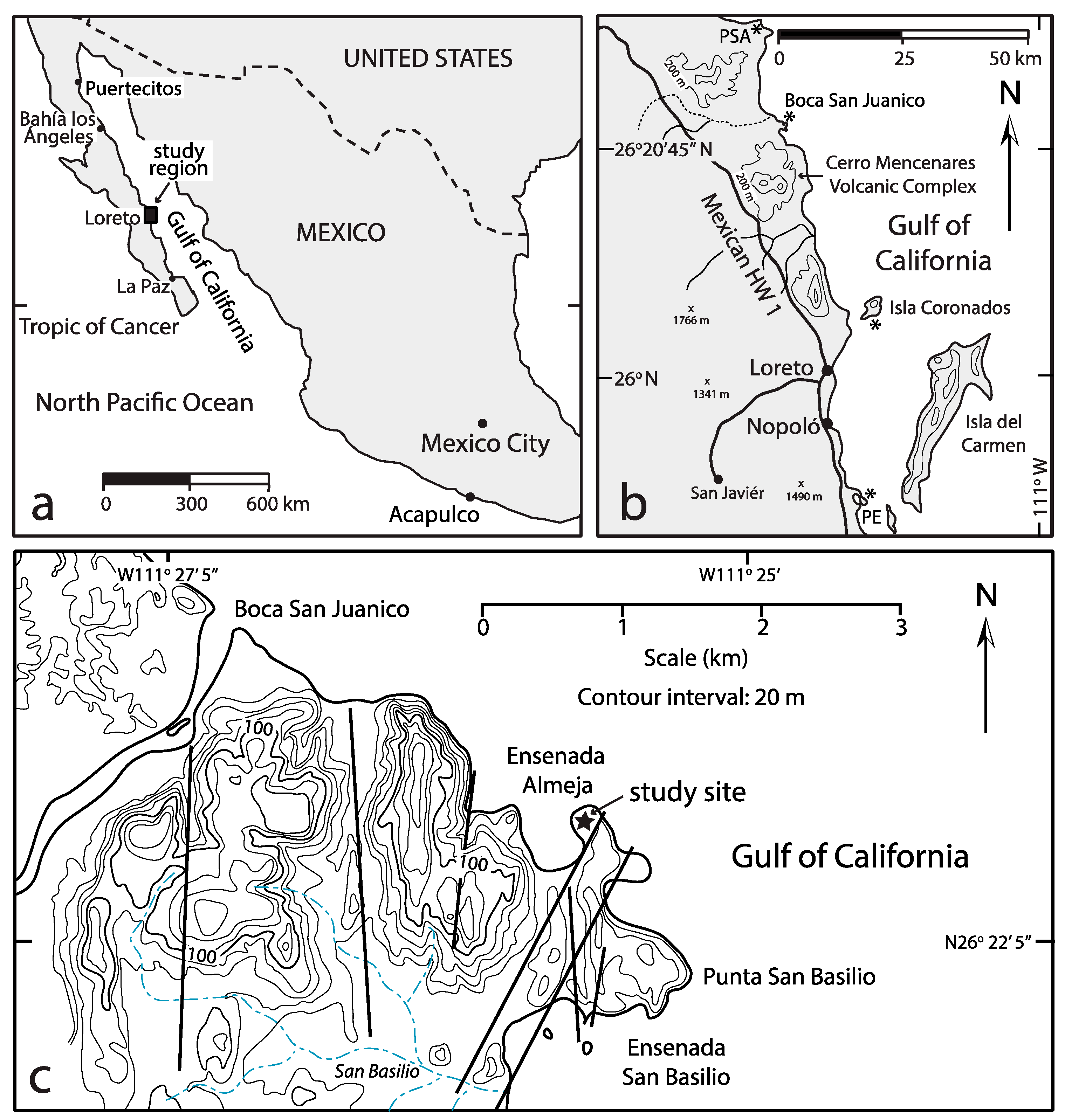
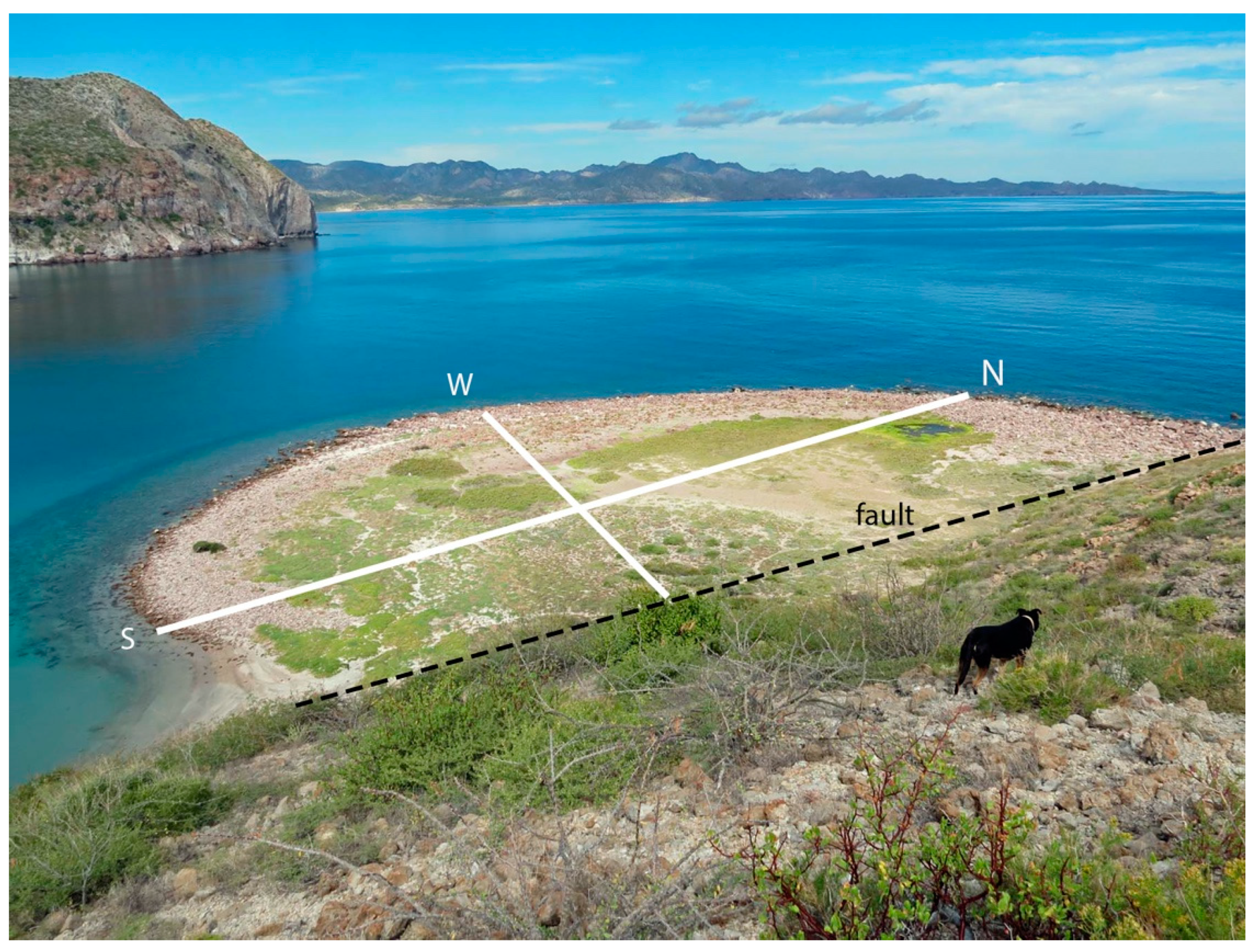
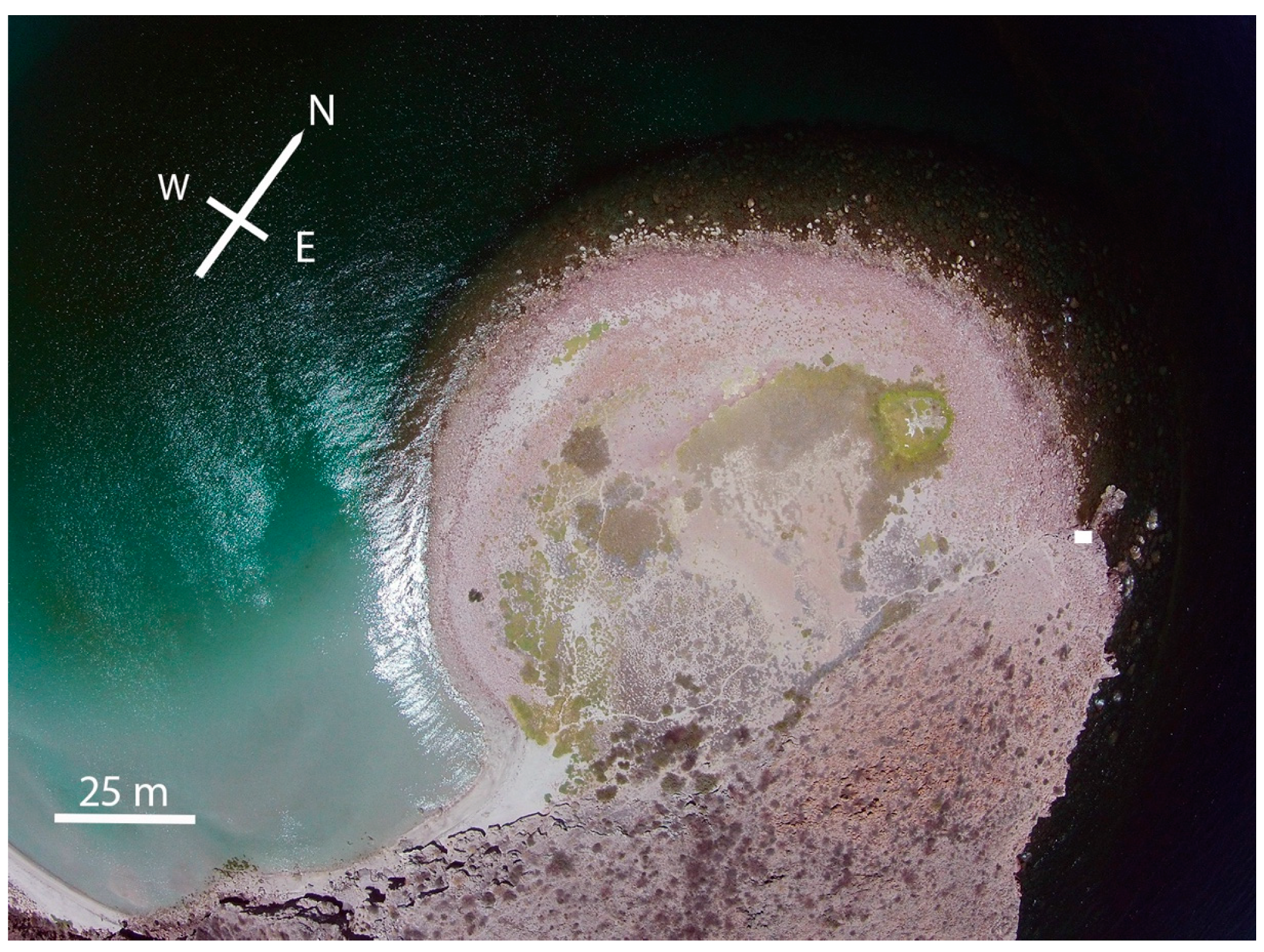
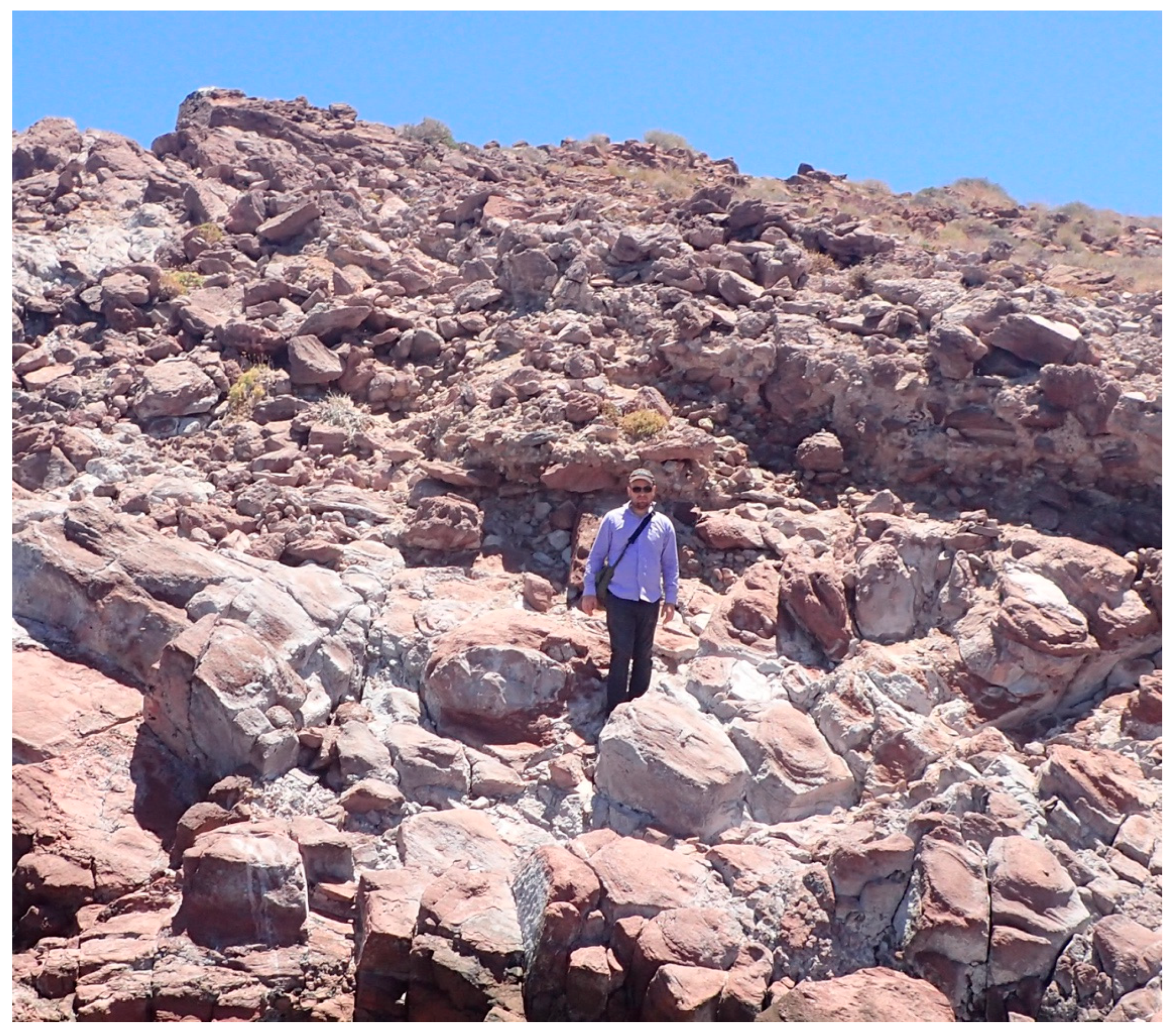
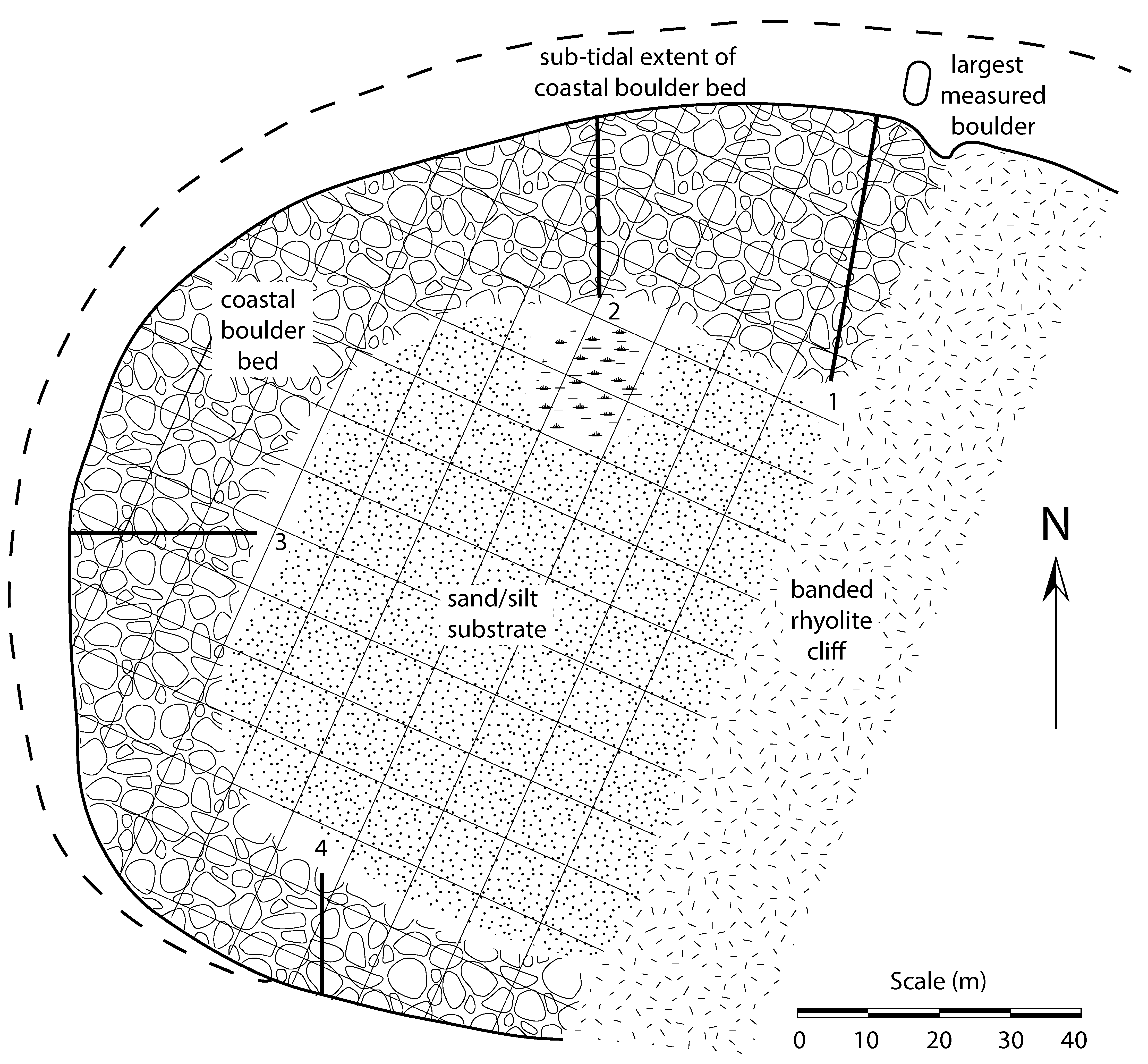
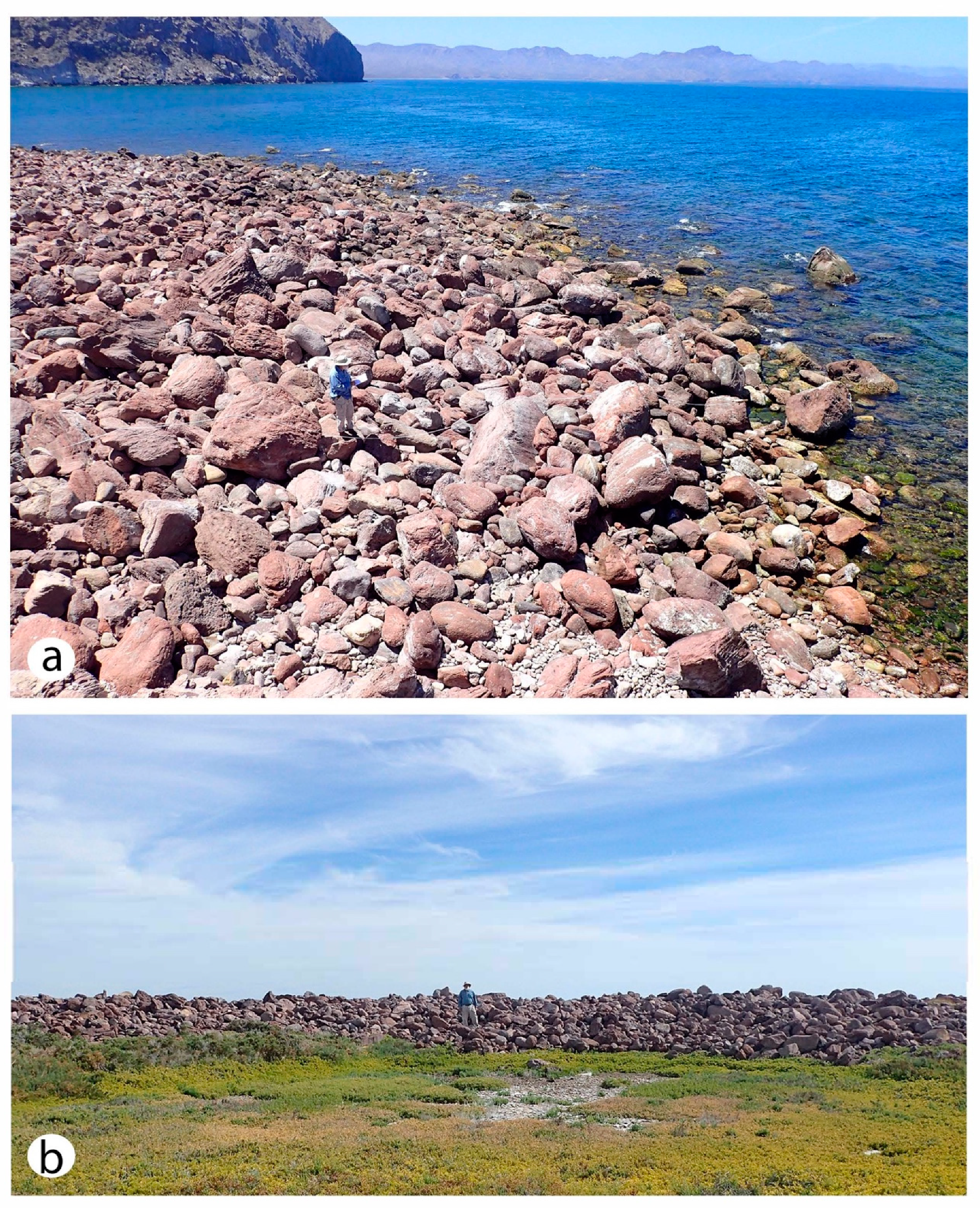
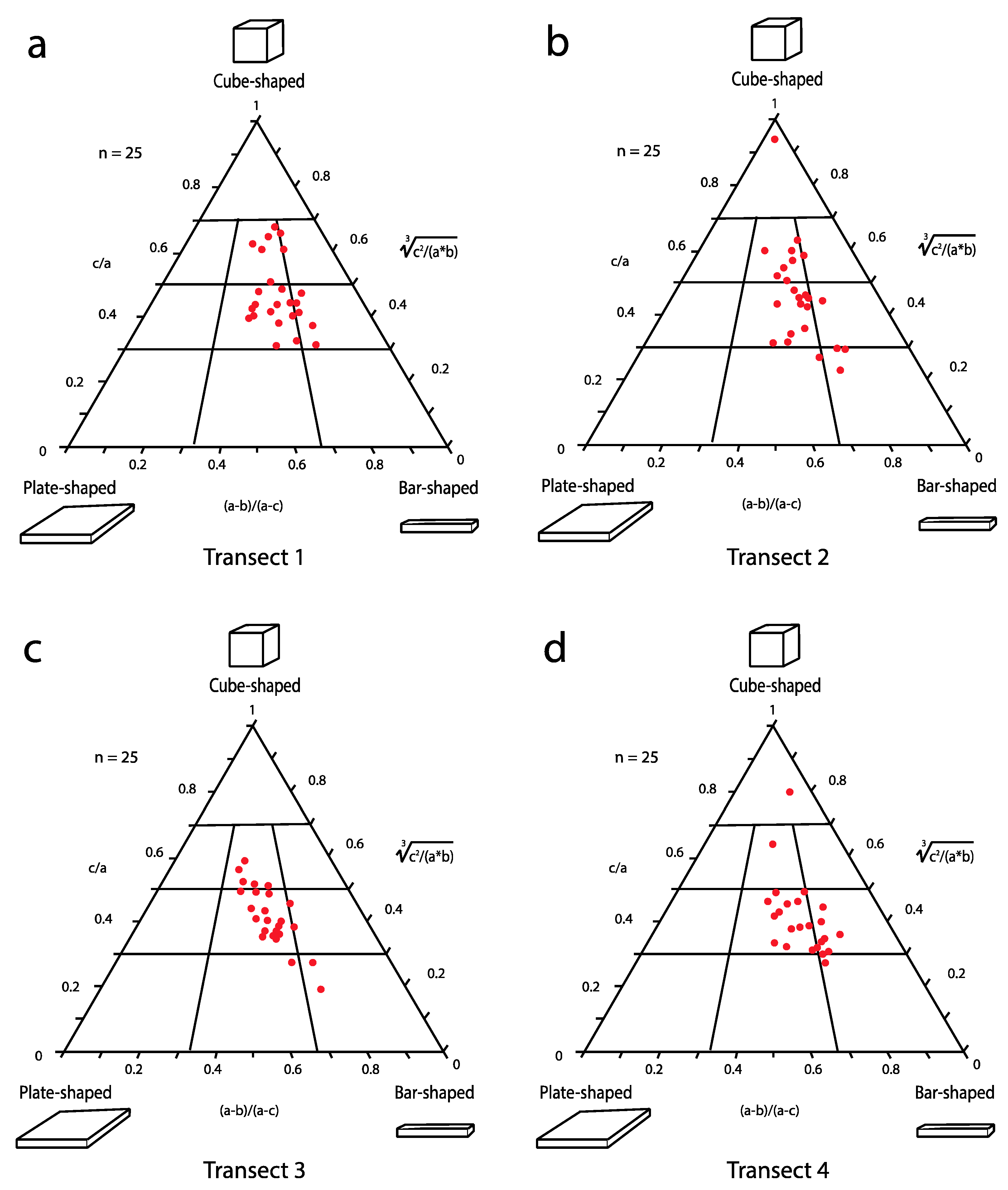
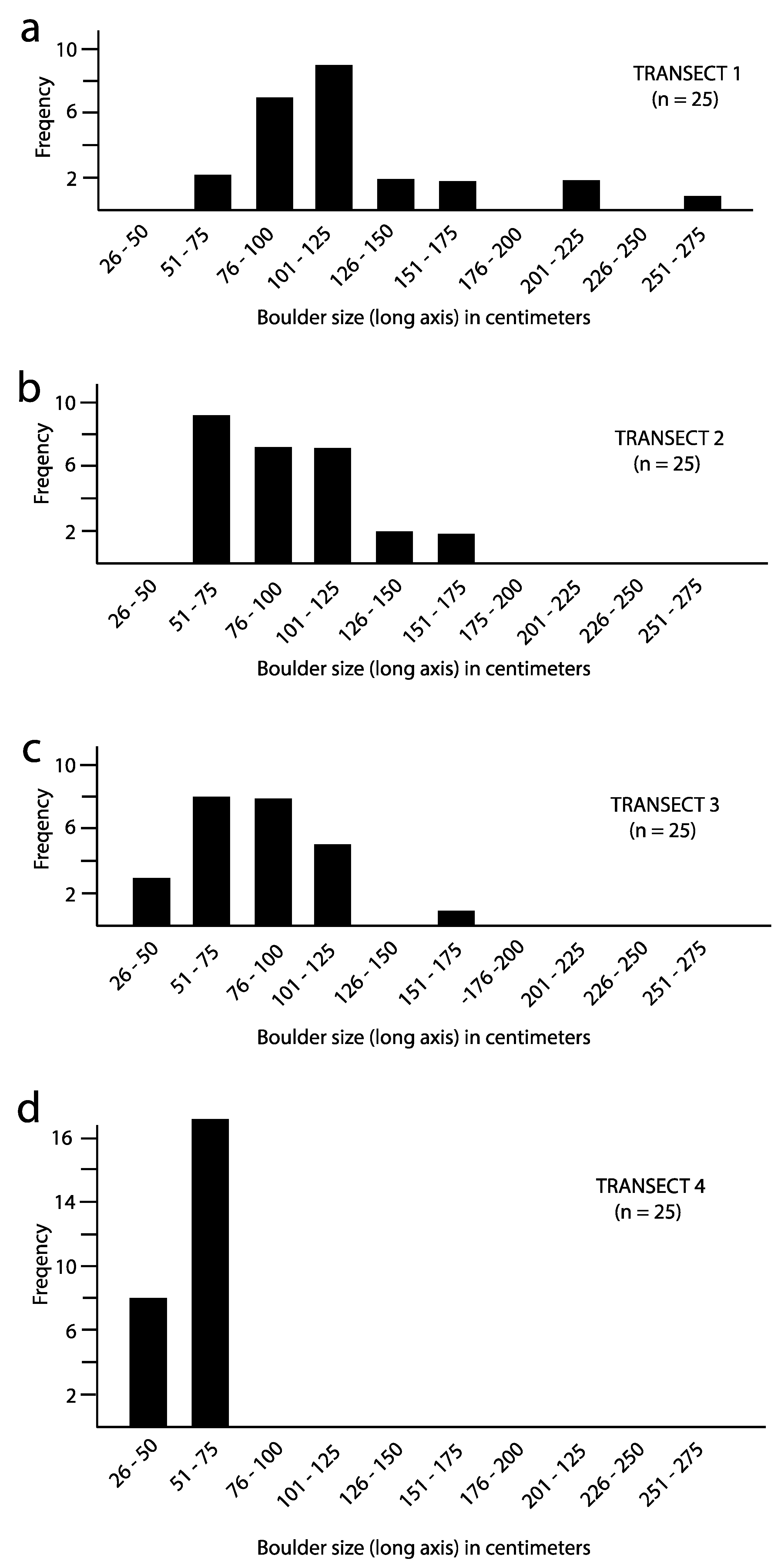

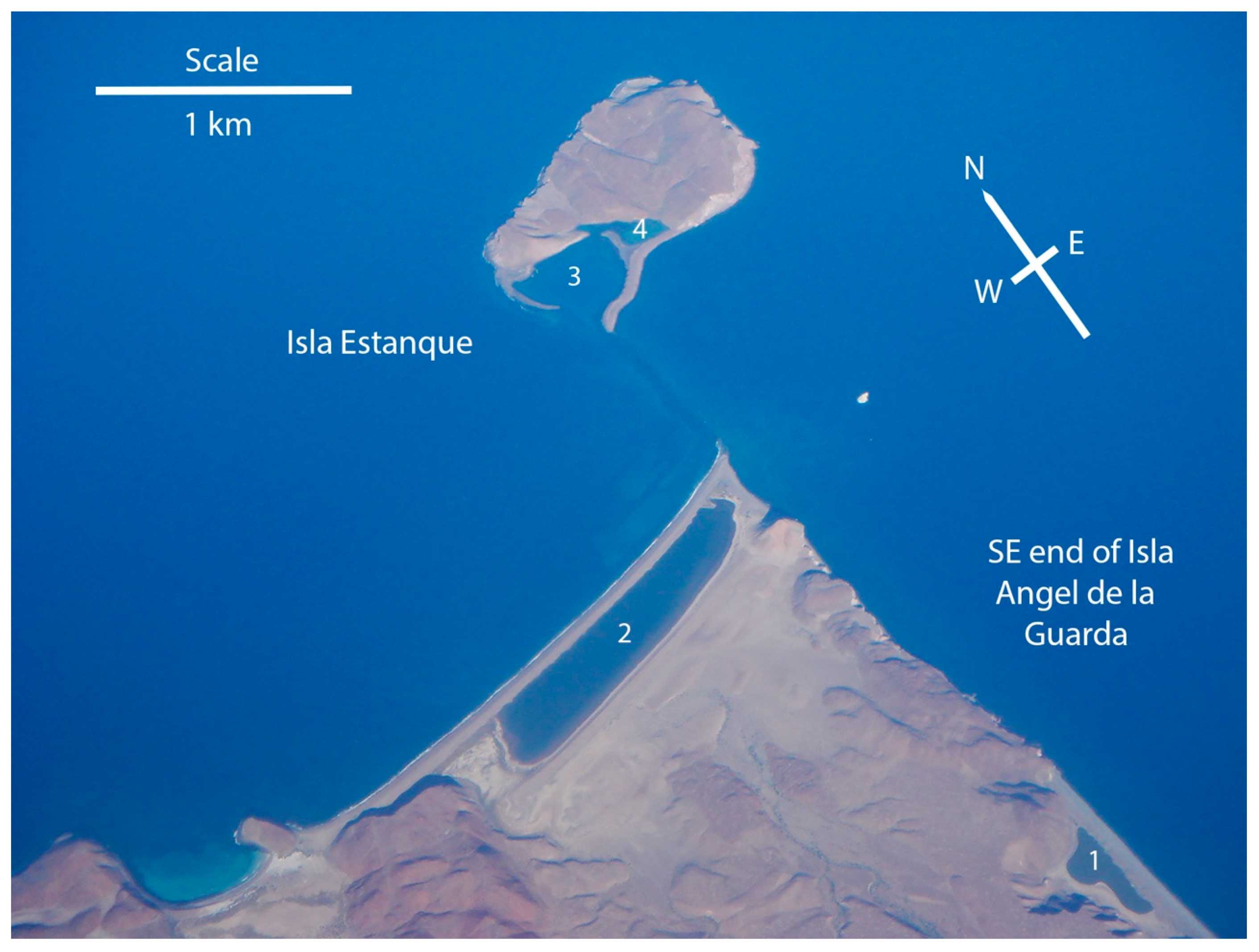
| Tran-Sect | Number of Samples | Average Boulder Size (cm3) | Average Boulder Weight (kg) | Estimated Average Wave ht. (m) | Max. Boulder Size (cm3) | Max. Boulder Weight (kg) | Estimated Wave Height (m) |
|---|---|---|---|---|---|---|---|
| 1 | 25 | 549,340 | 1,201 | 7.9 | 2,264,933 | 4892 | 13.7 |
| 2 | 25 | 182,974 | 395 | 6.0 | 608,546 | 1314 | 8.5 |
| 3 | 25 | 111,118 | 240 | 5.3 | 495,050 | 1069 | 10.3 |
| 4 | 25 | 34,032 | 69 | 3.5 | 111,004 | 240 | 4.7 |
© 2019 by the authors. Licensee MDPI, Basel, Switzerland. This article is an open access article distributed under the terms and conditions of the Creative Commons Attribution (CC BY) license (http://creativecommons.org/licenses/by/4.0/).
Share and Cite
Johnson, M.E.; Guardado-France, R.; Johnson, E.M.; Ledesma-Vázquez, J. Geomorphology of a Holocene Hurricane Deposit Eroded from Rhyolite Sea Cliffs on Ensenada Almeja (Baja California Sur, Mexico). J. Mar. Sci. Eng. 2019, 7, 193. https://doi.org/10.3390/jmse7060193
Johnson ME, Guardado-France R, Johnson EM, Ledesma-Vázquez J. Geomorphology of a Holocene Hurricane Deposit Eroded from Rhyolite Sea Cliffs on Ensenada Almeja (Baja California Sur, Mexico). Journal of Marine Science and Engineering. 2019; 7(6):193. https://doi.org/10.3390/jmse7060193
Chicago/Turabian StyleJohnson, Markes E., Rigoberto Guardado-France, Erlend M. Johnson, and Jorge Ledesma-Vázquez. 2019. "Geomorphology of a Holocene Hurricane Deposit Eroded from Rhyolite Sea Cliffs on Ensenada Almeja (Baja California Sur, Mexico)" Journal of Marine Science and Engineering 7, no. 6: 193. https://doi.org/10.3390/jmse7060193
APA StyleJohnson, M. E., Guardado-France, R., Johnson, E. M., & Ledesma-Vázquez, J. (2019). Geomorphology of a Holocene Hurricane Deposit Eroded from Rhyolite Sea Cliffs on Ensenada Almeja (Baja California Sur, Mexico). Journal of Marine Science and Engineering, 7(6), 193. https://doi.org/10.3390/jmse7060193







